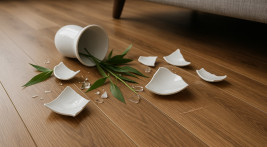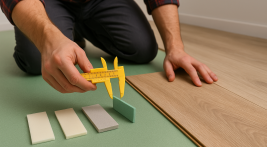Basic Information You Should Know
First of all, it is important to remember that laying laminate flooring on an uneven floor will cause damage in a short time. Therefore, it is crucial to properly prepare the subfloor so that any unevenness does not exceed 2-3 millimeters.
If you're not sure whether your floor is sufficiently level, you should check it beforehand. You can do this by placing a long aluminum bar or a straight board on the floor and sliding it across the entire room. If there are no gaps, it means the floor does not need leveling. Otherwise, the information on how to level a floor for laminate flooring will be helpful. Typically, unevenness that requires additional work is 5 mm or more.
Types of Materials for Leveling the Subfloor
Materials for leveling the floor are divided into two types: self-leveling and dry. The first type, self-leveling compounds, are used more frequently. They provide a quick and precise way to level the floor, but they are not suitable for every situation. They are not suitable for use in old buildings, which often require dry materials for floor leveling. It's also worth considering that the use of a self-leveling compound will extend the renovation time due to the necessary drying time, specifically the time needed for the water in the compound to evaporate. Available self-leveling compounds include cement-based, gypsum-based, and anhydrite-based options. Dry floor underlays are made of various wood-based materials as well as cement-fiber boards. Dry underlays are most commonly used where we want to lay new, beautiful, and durable wood-based laminate flooring over old, uneven wooden planks.
How to Level a Floor for Laminate Flooring
As mentioned above, the most commonly used method for leveling a subfloor for laminate flooring is self-leveling compounds. This not only allows you to perform the work yourself without hiring specialists, but also ensures that it will be done precisely as expected, meeting the requirements set by the laminate manufacturer. Self-leveling compounds are available for sale, which gradually spread across the floor, perfectly filling in any unevenness.
However, the procedure is not limited to just pouring the compound, as it is important to first carefully clean the surface and apply a priming compound. Only after the "primer" has dried can you proceed with the leveling compound, which should be spread starting from the furthest point from the door (so you can exit the room without any trouble). It is important to follow the instructions on the package and evenly distribute the leveling compound.
Finally, we remind you that in the case of old buildings, using a self-leveling compound may not always be possible. Therefore, before making a decision to apply it yourself, seek advice from a specialist at a flooring store, who will certainly provide wise guidance.





